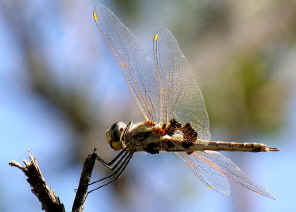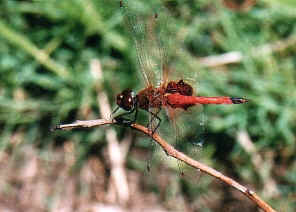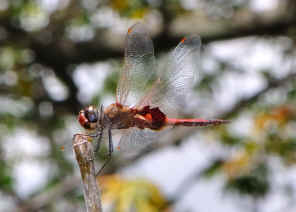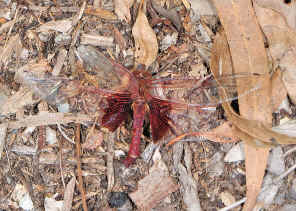|
| | Common Glider
Dragonfly - Tramea loewii (Trapezostigma loewii)
FAMILY
LIBELLULIDAE
- This page contains information and pictures of Common Glider Dragonflies that we found in the Brisbane area, Queensland, Australia.
-
 -
- This dragonfly is large
in size. Common Glider Dragonflies can be found on pond or very slow running large
area waters. Its abdomen is
short and narrow. Its wings are relatively narrow too but very long.
-
 
 -
Female
-
 

- Female, body length 50mm
-
- Female Common Gliders are dull brown in colour, with dark brown abdomen
tip. There are the brown patterns on hind-wings base. The patterns are
slightly different than the males.
-

 -
- We noticed on some Common Glider females we found there were many tiny
little brown balls attached under the body, as shown in the above photos. We
are not sure what are they. Could it be some kinds of parasite? Please advise
if you know what are they.
-
Male


 - Male, body length 50mm
-
-
The male Common Gliders have red abdomen with black tip. Its hind wing bases are
dark red in colour while the rest of its wings are clean, slightly tinted
with red.
-

  -
- Males show very strong territory behaviour. The
male usually glide within a favorite spot. If the same species male come near, they will drive them away.
On day time they usually gliding slowly or chasing each others rapidly.
-
-



-
- They spend half of the time flying and half of them time
resting. Near evening, those dragonflies will rest on tree top near the water.
They prefer to stay on twigs two meters above ground.
-
Egg-laying
- We noticed that the egg-laying habit of this Common Glider Dragonfly is a
bit different from other dragonfly species. So far we observed dragonflies
have three different egg-laying habits.
-
- 1. Female lays eggs alone, such as the Blue
Skimmer,
- 2. Female lay eggs guarded by a male, such as the Fiery
Skimmer,
- 3. Female lay eggs with male in tandem, such as the Water
Prince.
-
- We have detail discussions about dragonflies reproduction in this page.
-

 -

 -
- We noticed the Common Glider Dragonfly egg-laying habit is half-way
between point 2 and point 3. After mating, the male and female fly in
tandem. When the couple fly over a suitable egg-laying site, they separate
and the male changes the tandem position to holding the female as show in
the above photos. Then the female dip its abdomen tip into the water surface
and lays eggs. Then the couple resume the tandem position and looking for
another egg-laying site. the whole process takes less than a
second.
-
 
 -


- Reference:
- 1. The Australian Dragonflies - CSIRO, Watson, Theisinger &
Abbey,1991, p246.
- 2. Insects of Australia and New Zealand - R. J. Tillyard, Angus
& Robertson, Ltd, Sydney, 1926, plate 4.
- 3. A
Field Guide to Dragonflies of South East Queensland - Ric Nattrass,
2006, p107.
- 4. The
Complete Field Guide to Dragonflies of Australia - CSIRO, GŁnther
Theischinger and John Hawking, 2006, p296.
Back to Top
[ Up ] [ Common Archtail ] [ Black-headed Skimmer ] [ Blue Skimmer ] [ Fiery Skimmer ] [ Slender Skimmer ] [ Palemouth Shorttail ] [ Scarlet Percher ] [ Wandering Percher ] [ Black Faced Percher ] [ Red Arrow ] [ Red Swamp Dragon ] [ Graphic Flutterer ] [ Yellow-striped Flutterer ] [ Red Baron ] [ Short-tailed Duskdarter ] [ Water Prince ] [ Common Glider ]
| |
|



























